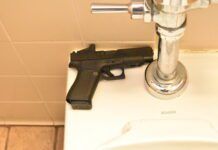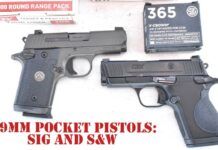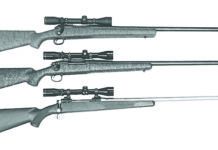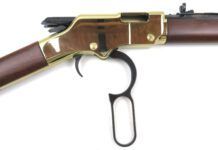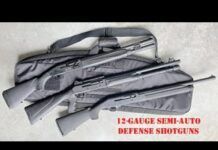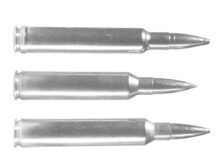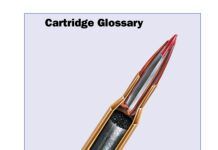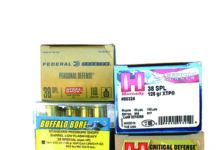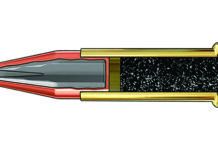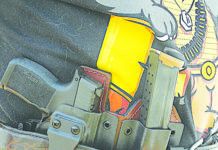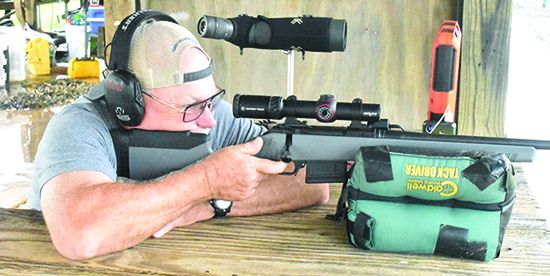Several major manufacturers are producing new firearms totally outside their normal niches, examples of which include the new Expedition rifle from Taurus and the new CBX Tac Hunter, a bolt gun from Colt.
That’s right, a rifle from Taurus, the handgun specialist. Their new bolt gun is one of the newest examples of lightweight, short-barreled hunting rifles so popular today. It is chambered in 308 Winchester and sports a polymer stock that is easy to carry and use, while also being set up for easily attached tripods and bipods. MSRP is $985, but we are seeing street prices around $765.
Long famous for their AR-15s, Colt is making the CBX bolt gun, $843, with a flat-bottomed fore end along with an angled pistol grip, a short-cycling bolt and controlled cartridge feed. These design elements should appeal to the hunter as well as a precision shooter.
How We Tested
Based on their dimensions, we can see that both rifles are short and handy, but can they shoot? We found out by firing the rifles at American Shooting Centers in Houston, using the same three loads we did with similar 308s in the August 2024 issue. The first was a Hornady Custom Lite 125-grain SST reduced-recoil load. Next were 150-grain Power-Shok rounds from Federal. Last came a load from Black Hills Ammunition featuring the 168-grain open-tip match bullet (OTM). As with our previous test on two other handy 308s, we used the excellent Eotech Vudu 1-10x scope for our optic. The size and magnification of the Eotech seemed to be a perfect match for our imagined uses of these rifles.
Colt CBX Tac Hunter CBX-SP20PGA-308 308 Winchester,
$843
Gun Tests grade: B+ [our pick]
We took off part of a grade for an adjustable trigger that didn’t adjust much. Once we were finished being very picky, we thought the Colt CBX shot very well and had some nice features.

| Action Type | Bolt, 60-degree throw |
|---|---|
| Overall Length | 39.75 in. |
| Barrel | 20 in. long, 1:10 RH twist, four grooves |
| Overall Height w/o Scope Mount | 6.0 in. |
| Weight Unloaded | 6.88 lbs. |
| Weight Loaded | 7.34 lbs. |
| Action | Stainless steel, black nitride finish |
| Barrel | Carbon steel, black nitride finish; muzzle thread 5⁄8-24 |
| Capacity | 5+1 |
| Magazine Type | Magpul AICS-pattern detachable box |
| Stock | Gray polymer Tac Hunter |
| Stock Drop at Comb | 0.5 in. |
| Stock Drop at Heel | 0.5 in. |
| Stock Bedding | Aluminum block |
| Stock Buttplate | Rubber |
| Stock Length of Pull | Adj., 12.75 to 14.25 in. 3 LOP spacers, 2 cheek risers |
| Receiver Scope-Base Pattern | Remington 700, #8-40 screws |
| Trigger Pull Weight | Adjustable, 3.46 lbs. |
| Safety | Two-position tang |
| Warranty | Limited 1 year, original owner |
| Telephone | (800) 241-2485 |
| Website | Colt.com |
| Made In | U.S. |
Colt Manufacturing has a long and storied history intertwined with the development of firearms in our country. Their 1873 Peacemaker, the Model 1911 semi-auto pistol, and Python revolver are American icons. No less so the M16/AR-15. Eugene Stoner may have designed it, but Colt gets the credit for buying the rights to the semi-auto ArmaLite Rifle and nurturing it into the successful system it is today.
Until recently, however, their efforts with bolt-action rifles have been few and foreign made. The year of 2024 changed that with a bolt gun made totally in the U.S. The first version (CBX Precision) was clearly aimed at the long-range precision market. It sports a full-length barrel, is chambered in 308 Winchester or 6.5 Creedmoor, and has an adjustable chassis. Most of the firearms world seems to be enamored with long-range shooting right now. Even if they can’t compete, folks want to be able to should the opportunity arise.
We also love accurate rifles — and we wouldn’t give you a plugged nickel for an inaccurate one. But not everyone needs or wants to carry a 16-pound long gun through the woods. Many manufacturers have discovered that the American public wants accurate and handy, both at a reasonable weight. Colt’s new CBX Tac Hunter comes with the same action as the Precision gun, a 20-inch barrel, and a lighter stock. The goal is accuracy and portability in one package. So how did they do?

We mention the Taurus Expedition and the way it borrows some features from the Remington 700. Taurus didn’t have to reinvent the wheel that way, and machining costs on tubular receivers are generally less than that of flat-based actions. There are many who hold that the flat-base action can potentially be more accurate than its round cousins. The primary advantage may lie in that flat base and the way it can be fit or bedded solidly into the stock. Done properly, there is very little chance that the action will twist and affect accuracy. Now take a guess at what style action the Colt uses? Flat base, of course, along with other notable actions, such as Accuracy International, Surgeon, Badger Ordnance, Winchester Model 70, and Howa with the 1500 Model. Oh, and a little company called Mauser. We would venture to call those rifles and actions a flat-out affirmation of a good concept.
The Colt CBX not only shows the Mauser lineage, but the build also spices up the recipe with some Savage, along with a dash of Remington. When we start with the action, we see the flat base and the integral recoil lug. This fits snugly down into the polymer stock and mates to an aluminum bedding block that runs from the front of the magazine almost to the tip of the fore end. When we tried to torque the stock around, we found that we could force it to touch the sides of the barrel, but it remained clear of the bottom of the barrel unless we used a great deal of pressure. The barrel is a 20-inch tube with a 1:10 inch twist, so it should be able to stabilize long 30-caliber bullets. The heaviest we tried was the Black Hills Ammunition 168 BTHPs, and the rifle did great. It starts out at about 1.03 inch in diameter at the receiver ring and tapered down to 0.64 inch just back of the thread protector. The result is a medium-weight hunting barrel that should be comfortable to carry. The muzzle is threaded 5⁄8×24, as expected for this caliber.
The Remington and Savage contributions are just as easy to spot. The barrel is secured to the action with a nut similar to the Savage system, making them easy to install and head space. The receiver is drilled and tapped for Remington 700–pattern bases, but this rifle uses #8-40 screws. Make sure your bases allow for that.

The rest of the working parts look to be whatever Colt thought would work best. The ejection port has a very open bridge, allowing easy access to the action. This would be an easy rifle to feed by hand, except that it is controlled feed, though not completely in the manner of the old Mausers and Winchesters. The bolt uses a full-diameter body with three pairs of locking lugs. The bottom lug, sitting at 6 o’clock, only extends half as far as the two above it. The result is a clear path for the case head to ride up the face of the bolt as it is pushed forward. The case rims slide under an extractor on the right side as it does so. Though it is not like the massive claw extractor on the Mauser, we still did not try to hand feed, so we didn’t have to worry as much about breaking the extractor.
The CBX also differed from a Mauser with a plunger-style ejector recessed in the bolt face at the bottom of the case head. Colt even designed a bolt that could be easily field-stripped by rotating the shroud clockwise. Add in an oversized bolt knob and a red-painted cocking indicator, and we thought this was a pretty good system. Removal is accomplished by depressing a tab directly in front of the bolt handle.
The Colt CBX uses an AICS-format detachable five-round box magazine made by Magpul. The polymer versions are light, relatively inexpensive (especially compared to metal versions), and worked well for us. The release is a paddle located in front of the trigger guard, and it can be activated by either hand.
The trigger turned out to be a little bit of a disappointment. The CBX presents a unit that is adjustable, supposedly from 2.5 pounds to about 5 pounds. Adjustment is simple. Remove the two action screws and lift the action out of the stock. A hex-head screw protrudes from the front of the trigger body. Counter-clockwise lightened the required pull weight, and clockwise movement added weight back. Our sample arrived with a required trigger compression of 3.86 pounds as measured by our Lyman Digital Trigger Gauge. Backing the screw out until we thought it was going to come out of the housing only lowered the trigger weight to 3.46 pounds. Is that an acceptable/usable trigger? Absolutely! But we’re trigger snobs and wanted the adjustable trigger to adjust a little more. The Taurus Expedition, for comparison, required 2.59 pounds, which was more to our liking.
We discussed the bedding block in the fore end, but the rest of the stock had some very nice features as well. The fore end was wide and flat enough to use well on a bag, while being trim enough to carry easily. It sports good texturing around the lower edges of the fore end, the vertical pistol grip, and just in back of the “butt hook.” Adhesion was sufficient without being overly aggressive. There are two sling-swivel studs on the fore end, allowing for a sling and a Harris-type bipod, along with the expected single stud on the buttstock. The stock comes with spacers for the length of pull, as well as a riser for the cheek. We try to do most of our field shooting with our shoulders perpendicular to the rifle to help with recoil control. That works best with a shorter length of pull, so we didn’t add in any spacers. We did mount the cheek riser, which got us closer to the line we needed for our scope, but wasn’t really high enough to get us all the way up. Still, we wound up with a very usable cheek weld. Everything on the butt end finished with a nice rubber buttpad, which we appreciated with these lightweight 308s.
With the Federal 150-grain Power-Shok ammo leading the way in compiling a 0.65-inch three-shot group average, all three loads averaged under 0.90 inch. The aggregate average was a comfy 0.79 inch.
Our Team Said: Slightly heavy trigger or not, this rifle would shoot. It appears that the bedding block and flat-bottomed action may have something going for them. We also really the liked the bolt and how easy it was to disassemble and clean.
| 308 WINCHESTER RANGE DATA | ||
|---|---|---|
| Hornady Custom Lite RR 125-grain SST 80866 | Taurus Expedition | Colt CBX Tac Hunter |
| Average Velocity | 2531 fps | 2433 fps |
| Muzzle Energy | 1779 ft.-lbs. | 1643 ft.-lbs. |
| Best Group | 1.05 in. | 0.83 in. |
| Average Group | 1.18 in. | 0.89 in. |
| Federal Power-Shok 150-grain PSP 308A | Taurus Expedition | Colt CBX Tac Hunter |
| Average Velocity | 2661 fps | 2713 fps |
| Muzzle Energy | 2359 ft.-lbs. | 2452 ft.-lbs. |
| Best Group 0.71 in. | 0.71 in. | 0.60 in. |
| Average Group | 1.03 in. | 0.65 in. |
| Black Hills Match 168-grain BTHP | Taurus Expedition | Colt CBX Tac Hunter |
| Average Velocity | 2553 fps | 2582 fps |
| Muzzle Energy | 2432 ft.-lbs. | 2487 ft.-lbs. |
| Best Group | 1.28 in. | 0.53 in. |
| Average Group | 1.46 in. | 0.81 in. |
We tested at American Shooting Centers in Houston. For accuracy testing, we fired multiple three-shot groups at 100 yards with the rifles supported in a Caldwell TackDriver Bag (Brownells 100-027-023, $49), further supported by a large rear bag, heavy from Tab Gear (TabGear.com, $34).
Written and photographed by Joe Woolley, using evaluations from Gun Tests Team members. GT



